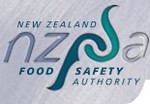A new approach to New Zealand's animal, plant and food based economy
The Government has announced a proposal to amalgamate the New Zealand Food Safety Authority (NZFSA) with the Ministry of Agriculture and Forestry (MAF), in a move that recognises that New Zealand’s animal, plant and food based economy needs a new cohesive approach, with a single risk management framework covering human, animal and plant life and health and associated risks to the environment.
While some say this is a sensible move that will provide a more cohesive view of the food sector, others fear it will come at the expense of consumers, claiming food safety will take a backseat in the new organisation. I don’t believe this is the case.
Food safety will benefit from being seen as part of the bigger picture, and an enormously important determinant for overseas trade which generates much of the wealth of this country.
New Zealand exporters will benefit as they are increasingly being asked for a wider range of official assurances for animal, plant, food and related products that go beyond traditional biosecurity ‘health and safety’ guarantees, and an amalgamated department would be much better equipped to ensure these are provided in a consistent and efficient way across the board.
This approach takes a wider view of the word ‘biosecurity’, meaning more than keeping out pests and disease. Both the United Nations’ Food and Agriculture Organization (FAO) and the World Health Organization (WHO) use the term ‘biosecurity’ to describe a strategic and integrated approach to analysing and managing risks to human, animal and plant life and health, and associated risks to the environment. To ensure New Zealand remains a healthy and wealthy nation, this is how we need to see biosecurity as well.
Forming a new organisation from NZFSA and MAF will provide the platform for New Zealand to better manage this broader interpretation of biosecurity risks. Bringing functions together into a single department that systematically applies a robust risk management framework to all issues – including domestic food safety and nutrition – will better serve the unique biosecurity and trade needs of New Zealand.
Those of us in the state sector who regulate in the area of the so-called ‘biological economy’ can jointly be regarded as guardians of ‘brand New Zealand’, hand-in-hand with industry. NZFSA and MAF are both highly regarded around the world and amalgamating them into a new organisation, which spans the full primary industries value chain, will inevitably enhance the excellent reputation our meat, dairy, seafood, produce and manufactured food products have rightly gained over the years.
Taking a whole-of-system approach to biosecurity issues across the whole paddock to plate spectrum will also inevitably suggest ways to make regulatory interventions even more cost-effective in both domestic and export sectors.
It’s also important to note that the costs of the amalgamation are not being funded by industry, but by Crown funding. NZFSA recovers up to 60% of its total budget from industry to reflect the services that are provided to industry. While the amalgamation won’t have any great impact on cost recovery, the new organisation will try to deliver efficiencies to counter any increases in costs and therefore cost recovery.
Joining MAF and NZFSA into a new agency is a sensible move, particularly as both organisations are high performing and well-respected. Amalgamating them will bring the regulatory functions together into a single ‘competent authority’ covering ‘biosecurity’ in its true sense of human, animal and plant health as well as environmental protection, and the economic benefits that these deliver. Domestic food safety and nutrition will only benefit from this approach, and I look forward to seeing the new organisation set itself up to deliver tangible benefits for the food industry and for consumers.
